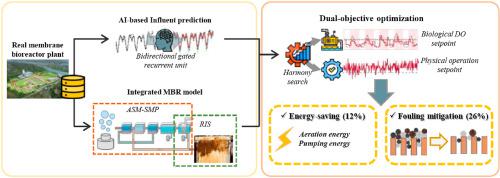Journal of Membrane Science ( IF 9.5 ) Pub Date : 2021-02-25 , DOI: 10.1016/j.memsci.2021.119208 KiJeon Nam , SungKu Heo , GaHee Rhee , MinJeong Kim , ChangKyoo Yoo

|
Optimal operational strategies for wastewater treatment plants have been employed widely to improve the economic and environmental operations. However, inadequate optimization systems have been applied to membrane bioreactor (MBR) plants, resulting in high energy consumption due to uncertain influent associated with complex biological and physical interactions associated with membrane fouling. Here, we develop a dual-objective optimization system based on harmony search algorithm via process simulation. A bidirectional gated recurrent unit produced the most accurate predictions of fluctuating variations in hourly influent among competing models. And the predicted influent information was used to suggest operational strategies. The optimization system searched predictive operational strategies, including aeration intensities and permeation-cleaning durations, using the integrated biological and physical model. The suggested aeration intensities were then used for scouring air on membrane surfaces when the permeation-cleaning duration was optimized. A pilot MBR plant equipped with the suggested optimization system improved energy efficiency by 4% and mitigated fouling by 39% compared with a manually operated system. Dual-objective optimization also demonstrated feasibility and reliability at a full-scale MBR plant by increasing energy efficiency by 12% and decreasing fouling by 26%.
中文翻译:

使用基于AI的进水量预测和集成的生物物理模型对MBR工厂中的节能和结垢缓解进行双目标优化
废水处理厂的最佳运行策略已被广泛采用,以改善经济和环境运营。然而,不足的优化系统已应用于膜生物反应器(MBR)工厂,由于与膜污染相关的复杂生物和物理相互作用相关的不确定进水量,导致高能耗。在这里,我们通过过程仿真开发了一种基于和谐搜索算法的双目标优化系统。双向门控循环单元产生了竞争模型之间每小时进水口波动变化的最准确预测。并使用预测的进水信息来建议操作策略。优化系统搜索了预测性运营策略,使用集成的生物和物理模型,包括通气强度和渗透清洁持续时间。然后,当优化了渗透清洁时间后,建议的曝气强度将用于洗涤膜表面的空气。与手动操作系统相比,配备了建议的优化系统的MBR试点工厂将能源效率提高了4%,并将结垢减少了39%。双目标优化还通过将能源效率提高了12%,并将结垢减少了26%,证明了在大型MBR工厂中的可行性和可靠性。与手动操作系统相比,配备了建议的优化系统的MBR试点工厂将能源效率提高了4%,并将结垢减少了39%。双目标优化还通过将能源效率提高了12%,并将结垢减少了26%,证明了在大型MBR工厂中的可行性和可靠性。与手动操作系统相比,配备了建议的优化系统的MBR试点工厂将能源效率提高了4%,并将结垢减少了39%。双目标优化还通过将能源效率提高了12%,并将结垢减少了26%,证明了在大型MBR工厂中的可行性和可靠性。


























 京公网安备 11010802027423号
京公网安备 11010802027423号